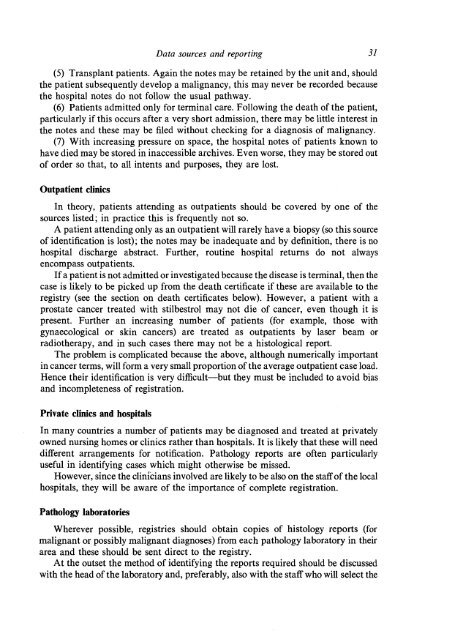Cancer Registration: Principles and Methods - IARC
Cancer Registration: Principles and Methods - IARC
Cancer Registration: Principles and Methods - IARC
You also want an ePaper? Increase the reach of your titles
YUMPU automatically turns print PDFs into web optimized ePapers that Google loves.
Data sources <strong>and</strong> reporting 3 1<br />
(5) Transplant patients. Again the notes may be retained by the unit <strong>and</strong>, should<br />
the patient subsequently develop a malignancy, this may never be recorded because<br />
the hospital notes do not follow the usual pathway.<br />
(6)' Patients admitted only for terminal care. Following the death of the patient,<br />
particularly if this occurs after a very short admission, there may be little interest in<br />
the notes <strong>and</strong> these may be filed without checking for a diagnosis of malignancy.<br />
(7) With increasing pressure on space, the hospital notes of patients known to<br />
have died may be stored in inaccessible archives. Even worse, they may be stored out<br />
of order so that, to all intents <strong>and</strong> purposes, they are lost.<br />
Outpatient clinics<br />
In theory, patients attending as outpatients should be covered by one of the<br />
sources listed; in practice this is frequently not so.<br />
A patient attending only as an outpatient will rarely have a biopsy (so this source<br />
of identification is lost); the notes may be inadequate <strong>and</strong> by definition, there is no<br />
hospital discharge abstract. Further, routine hospital returns do not always<br />
encompass outpatients.<br />
If a patient is not admitted or investigated because the disease is terminal, then the<br />
case is likely to be picked up from the death certificate if these are available to the<br />
registry (see the section on death certificates below). However, a patient with a<br />
prostate cancer treated with stilbestrol may not die of cancer, even though it is<br />
present. Further an increasing number of patients (for example, those with<br />
gynaecological or skin cancers) are treated as outpatients by laser beam or<br />
radiotherapy, <strong>and</strong> in such cases there may not be a histological report.<br />
The problem is complicated because the above, although numerically important<br />
in cancer terms, will form a very small proportion of the average outpatient case load.<br />
Hence their identification is very difficult-but they must be included to avoid bias<br />
<strong>and</strong> incompleteness of registration.<br />
Private clinics <strong>and</strong> hospitals<br />
In many countries a number of patients may be diagnosed <strong>and</strong> treated at privately<br />
owned nursing homes or clinics rather than hospitals. It is likely that these will need<br />
different arrangements for notification. Pathology reports are often particularly<br />
useful in identifying cases which might otherwise be missed.<br />
However, since the clinicians involved are likely to be also on the staff of the local<br />
hospitals, they will be aware of the importance of complete registration.<br />
Pathology laboratories<br />
Wherever possible, registries should obtain copies of histology reports (for<br />
malignant or possibly malignant diagnoses) from each pathology laboratory in their<br />
area <strong>and</strong> these should be sent direct to the registry.<br />
At the outset the method of identifying the reports required should be discussed<br />
with the head of the laboratory <strong>and</strong>, preferably, also with the staff who will select the
















